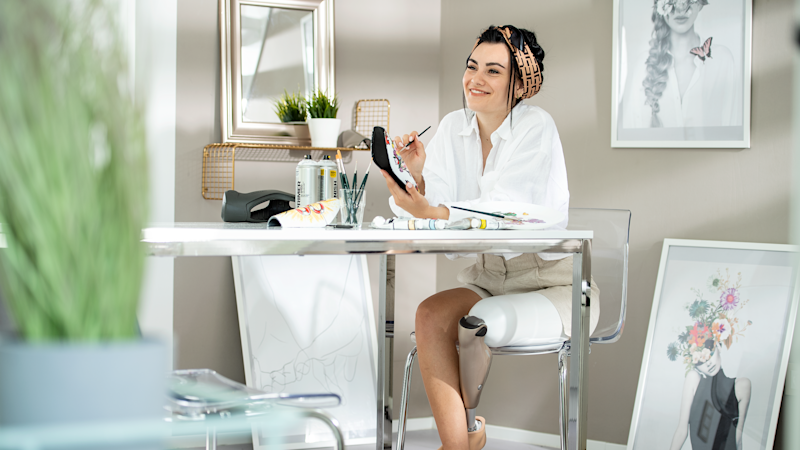The new C-Leg: "My prothesis is a great eye-catcher"
Fashion student Rebecca Brunner about painting her new C-Leg covers

THE NEW C-LEG: "MY PROSTHESIS IS A GREAT EYE-CATCHER"
Fashion student Rebecca Brunner about painting her new C-Leg covers
Fashion student Rebecca Brunner from Austria lost her left leg in a moped accident. accident. She thinks it is important that her prosthesis is not perceived as something negative. Immediately after the first fitting she began to paint it: "With the adjustable protective shield I can play with colors and motifs," says the 21-year-old. She dedicated her final project "Game of life" to individual prosthesis designs: "If you're already in a situation that you can't change, you can at least make the best of it. My C-Leg has thus become a part of my personality!"
Four years ago, you were involved in an accident with your moped, as a result of which your leg was amputated. How would you say you've developed personally?
I feel I've really come a long way. Of course I didn't really have any alternative! I'm glad I was young and adaptable when it happened, because that probably made it easier for me to adjust.
You're interested in fashion and beauty, and study at a school of fashion design. Has your accident changed the way you perceive beauty?
Definitely. It's shown me that you can take anything life hits you with and turn it into something positive for yourself. I've learned that even flaws can be beautiful, and that supposed weaknesses can be turned into strengths. Fashion can have different effects, depending on how you wear it. If you have a confident personality and people sense that you're comfortable in your own skin, you automatically appear more attractive to them – and vice versa. The same is true of the prosthesis. I've now started to get to grips with it on a deeper level.
Why did you start changing the look of your prosthesis?
I wanted to create something more individual, more special. It started when it occurred to me that I could process the whole prosthesis situation much better by tackling it head-on. So I made an active effort to make the best of it. It really helped me to accept it.
So how exactly do you beautify your prosthesis?
I use paint to draw my own pictures on the replaceable cover. I also get a car paint shop to spray my prosthesis in new colours, such as metallic gold. And I've sewn various fabric covers with elasticated tops and bottoms that I can slip over the prosthesis.
Prostheses are medical devices. Do you have to be very careful?
I've always discussed the whole process first with my O&P professional to make sure I'm not about to damage anything. Also, most of the materials I use are self-adhesive. The paints I use have to be suitable for the prosthesis material and not damage it, of course. I always draw the image on a piece of paper first and then copy it onto the shield. I usually don't have a real plan, I just start scribbling until I come up with an idea I like, and then I finalise it.
What happens if you decide you no longer like a particular colour? Can you paint over it? How much does that cost?
If there ever comes a point in time when I don't like a colour any more, I'm sure it won't be a problem to paint over it. But before I begin, I always think long and hard about the long term. It costs me around €200 to have the shaft and cover sprayed with car paint.
Acrylic paints are good for the shield, they wear well and work better than oil-based paints. I definitely want to incorporate a pattern next time. Maybe I'll even go for something abstract. Next time I want to try something a bit louder, more colourful.
If you start working for a fashion company, what will be your goal?
To create more fashion choices for people with disabilities. By which I don't necessarily mean designing and sewing clothes differently – it's more about the way they're presented, to begin with. People who wear a prosthesis don't necessarily need different types of clothing. I want to show the world that dresses and skirts look just as good on women with prostheses as they do on women with two healthy legs!
Some fashion magazines now include women who wear prostheses. The digital cover of Vogue Arabia, for instance, recently featured Zainab Al-Eqabi wearing an Alexander McQueen dress!?
I'm convinced the fashion world is moving in the right direction. People are less wary than they once were. Seeing what others have achieved is inspiring and encouraging. It shows you just how much you can make of a challenging situation, and that it's worth accepting the prosthesis as a part of your identity, not as some foreign object attached to your body. It's something that belongs to you, and you should wear it just the way you want to.
Talking of prosthesis design, do you prefer a high-tech look or a natural look?
I'm definitely an advocate of the high-tech look. In my opinion, a prosthesis is something special, something you can flaunt! I'm proud to wear something so unique, which is why I prefer to showcase it and not hide it under a natural-look foam cover.
So how exactly do you "showcase" your prosthesis?
I display my prosthesis openly. I actually feel most comfortable wearing dresses and skirts. I like accessorizing my outfits with jewellery, and a prosthesis in a matching colour is like an extra accessory. On days when I'm not wearing bright colours, the prosthesis is a great eye-catcher.
Thank you!
Rebecca Brunner (Credit: Ottobock)
Rebecca Brunner painting (Credit: Ottobock)
Rebecca Brunner going downstairs (Credit: Ottobock)
3 results out of 3
